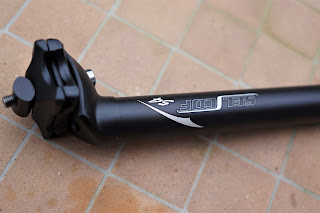Phantom squeaks have been a
recurrent theme, these past weeks. Having confirmed my Univega’s Bottom
bracket, left crank wasn’t on the eve of expiry, I relaxed and racked up
another 200miles.
SQR brackets can be subject to
a fair bit of stress-10kilos, potentially. However, they mustn’t be torqued too
tight.
I decided the bracket needed
moving upwards, closer to the post cradle. Part of this was aesthetic-closing
the gap. However, upon removing the titanium post, I discovered (with a mix of
surprise and horror) it had developed a very clear crease, which suggested
failure, and with it, possible impalement.
Not something I was prepared
to ignore. Decent quality posts are either 27.2 or 31.8 these days.
Standardisation of this kind is generally a good thing. Keeps manufacturing
costs lower and ultimately, this is reflected in prices, for the end consumer.
However, my Univega was
manufactured in 1996, when 26.0, 26,4 and 26.8 were quite common. These days,
its still possible to get posts in these diameters but, these are often quite
crude, and relatively hefty. There are still some titanium/similar exotica
floating about online. However, as attached as I am, to the “Old girl” economics
are significant, in principle and practice.
A decent 6061 post will hold the
saddle up, just with a minor weight penalty. Choice was boiling down to another
BBB Skyscraper. (400mm long, nice aesthetics and low weight) or a similarly worthy
System EX… Then along came this Selcof… Bankrupt stock and a penny shy of £10-
half the price. Decision made.
I really rate the SQR system.
However, its worth making a shim from old inner tube, to protect hosts from
being scratched by the aluminium clips.
Black anodised, and dun
finishes are particularly vulnerable to this sort of cosmetic damage. A
straight sleeve. made from inner tube offcut worked fine.
The post has been topped off
with a Selle Italia sport gel flow saddle, which arrived for testing. I’ve
found it tricky, getting a perch that really suits my derriere, on the Univega,
in its present guise.
Ironically, given the bike’s
relatively upright configuration, an ordinarily perfect 143mm with tends to
chafe my inner thigh. The Selle Italia Sport Gel is 270mm long, 140mm wide. Narrower
than might be expected, of a model claimed to offer high level performance to “occasional riders for whom time on the bike can be scarce. The
Sport Gel Flow strikes the perfect balance between sporty design and total
comfort, the best way to enhance your riding experience”.
400 mixed terrain miles should
give me much better insight but forty miles in, the gel padding density, shape
and FEC alloy rails are a proving a good fit. I’ve
also received this Easton Pin Line EVA foam road bar tape, for testing. The
Tubby tourer seems a good fit, for these duties.
The Microshift M45 rear mech
is still doing the business, six years down the line. There’s little obvious “slop”,
either which comes as a pleasant surprise, although there are traces of the
salt monster’s caustic tongue, along the painted steel cage. I can see
something like Shimano Alivio M4000 Shadow replacing it, when time comes.
As for my beloved fixed, I’ve
exchanged the Axiom Grand Fondo wedge pack, for this Carradice SQR tour, which
has been in my possession, some eighteen years. The SQR tour is made from waxed
cotton duck, a very hard wearing, waterproof fabric. However, it’s less
convenient to clean, compared with the Carradry’s ultrasonically welded PVC.
Reverting to this old friend
meant forgoing my fixed gear winter/trainer’s post mounted guard. However, this
isn’t a big sacrifice, given the Tour’s wide profile and partially laminated
bottom, offers decent protection from rain and spray.
On the subject of grotty
stuff, Steve’s reached his conclusions, regarding Oxford Product’s Mint bike
wash https://www.sevendaycyclist.com/oxford-mint-bike-wash
and I’ve generally been impressed by their
torque workshop stand. https://www.sevendaycyclist.com/oxford-torque-workshop-stand
Oh, and this bike beautifying
bundle has just arrived from Velo 21.









































